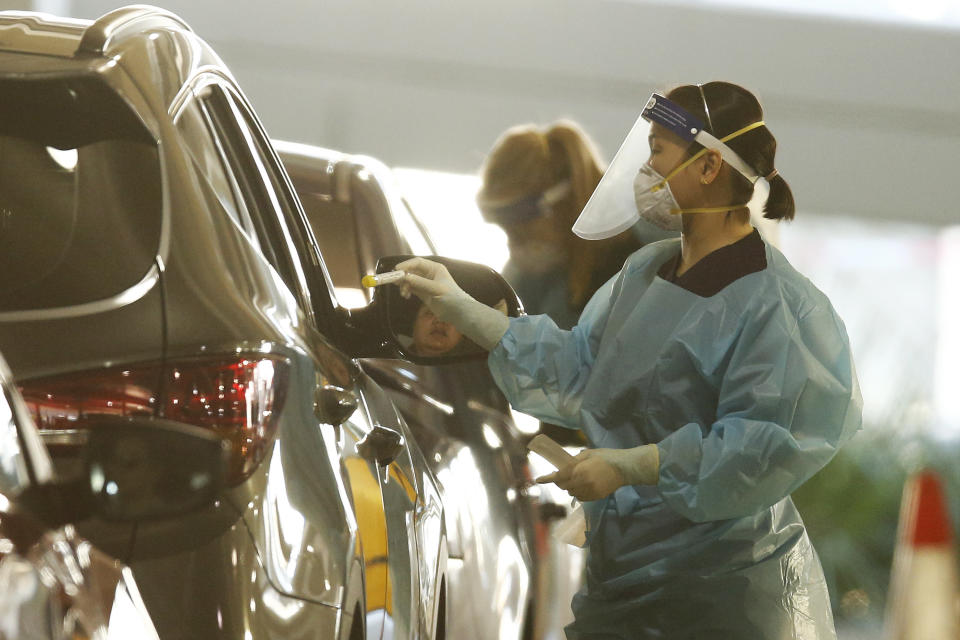'Critically important': Expert calls for vital new move in Victoria's virus hotspots
An epidemiologist has suggested Victoria adopt a new testing tactic to help develop a true understanding of how much coronavirus infection is in the community as the state’s testing rates continue to drop off.
On Tuesday, Victoria processed just 8,704 tests in the previous 24 hours, making it the first time since Stage 4 restrictions were introduced on August 2 that the daily figure dropped below 10,000.
Premier Daniel Andrews told reporters the figure was far lower than health authorities were seeking and stressed sufficient levels of testing was “critically important” in navigating the state out of lockdown.
“It is that sort of intelligence, that data, which allows us to have the best public health response and greatest certainty about how much virus is out there in the Victorian community,” he said.
In August, Chief Health Officer Brett Sutton said he would like to see tests over 20,000 each day. That has only been achieved twice in the past two weeks.
Wednesday’s testing total was 16,786.
Testing rates are routinely higher in NSW and Queensland in recent weeks. Mr Andrews has previously warned low testing rates could delay the reopening of the state.
Pool testing of hotspot areas
While regularly pressed on allowing people with no symptoms to come forward to get tested, particularly in hotspots, Prof Sutton has rejected such calls, insisting it is “low yield”.
However, Dr Zoe Hyde, an epidemiologist at the University of Western Australia Medical School, said the state could adopt a testing tactic which allows health teams to test large amounts of asymptomatic people for the virus.
“Pooled testing of suburbs and environments which are considered particularly high risk might be a useful next step,” she told Yahoo News Australia.
Pooled testing involves testing multiple people by using multiple samples in only one test.
If the test is negative, it indicates all the people involved – for example 20 residents in a hotspot area of Melbourne’s north – do not have COVID-19, proving to be a more efficient and cost-saving process.

If positive, those people are then subject to individual tests to find the source of the positive test.
“This would give us a better idea of how many undetected cases there might be in the community,” Dr Hyde said.
Beijing set out to test large swathes of its population in specific suburbs after a surge in cases in June regardless of whether people had symptoms or not.
The city successfully pooled five swabs into one test, resulting in more than 7 million people tested in less than two weeks and contributed to authorities stamping out the virus.
The system could prove useful for Apollo Bay, 200km southwest of Melbourne, where the virus was found in sewage.
A recent testing push of symptomatic people has so far failed to detect any cases in the area.
Static testing target ‘not helpful’
Dr Hyde told Yahoo News Australia a targeted testing approach is more beneficial than setting a desired static testing rate for the whole state, while focusing on the percentage of people testing positive.
“I think specifying a target for the number of tests we want to see performed each day isn’t necessarily helpful,” she said.
“A more meaningful measure is the proportion of people testing positive.”
Epidemiologist, Professor Raina MacIntyre at the University of NSW, previously told Yahoo News Australia the number of tests will differ as the virus is suppressed in the community.
“The testing rates are not a static number – they should shift according to how much infection is being detected,” she said.
On Tuesday, Mr Andrews admitted that as restrictions continued, there would be less symptomatic people in the community, especially as cold and flu will have been suppressed.
He pleaded with people who have symptoms to get tested as their chances of being infected were far greater.
“Because cold flu is so low, if you even have mild symptoms, the chances of you having this coronavirus are that much higher,” Mr Andrews said.
Do you have a story tip? Email: newsroomau@yahoonews.com.
You can also follow us on Facebook, Instagram and Twitter and download the Yahoo News app from the App Store or Google Play.





